Plague Doctors and Cannibals: Food Fights is a Playful History of Cuisine
Images courtesy of The Overlook Press Food Features
Ten years ago, Tom Nealon attempted to cook every meal found in Chaucer’s Canterbury Tales. As he writes on the very first page of his quirky new book, Food Fights & Culture Wars: The Secret History of Taste, he had just “ended a run of bad restaurant jobs to open my used bookshop in Boston,” and he possessed a “dilettante’s interest in the food of the late Middle Ages.” He encountered some trouble with a recipe for roasted peacock—“stymied by the fact that it is apparently illegal to kill peacocks”—but enjoyed the mashed-up pork dish called mortorio he prepared with only the imprecise directions of a fourteenth-century scribe.
Nealon, the proprietor of Pazzo Books, channeled his newfound passion into researching culinary history, mostly through early cookbooks with their bizarre ingredients, inexact measurements, and pseudo-medicinal claims. His heavily illustrated book, published by the British Library last fall and available now from Overlook Press, is the product of that journey. He shares answers to trivia like, “Why is the turkey called a turkey, when it is from the Americas?” in the book’s introduction, but it is in the ensuing ten themed chapters that he probes his subjects in greater detail, serving up the literary equivalent of tapas: elegant, nourishing, and enjoyable stories that leave room for what comes next.
As with those small, delicious dishes, a favorite among the offerings here is hard to choose, but “Lemonade and the Plague” undoubtedly ranks high. In 1668, bubonic plague inched closer to Paris, having already taken more than 100,000 people in London between 1665-66. The dreaded “Black Death,” which we now know was spread by fleas infected with Yersinia pestis bacteria riding on the backs of rats and gerbils, was all too well known in European cities for hundreds of years, but Paris was largely spared this time around. Nealon credits the lowly lemon for that—and not because locals were ‘detoxifying’ with hot water with lemon. He contends that it was the Parisian obsession with lemonade (limonadiers were “ubiquitous,” he writes) that saved the city. Rats nibbled through heaped piles of discarded lemon peels, containing high amounts of limonene, a natural insecticide still in use today, which exterminated the parasitic pests and disrupted the epidemic’s transmission.
Denizens of the seventeenth-century could never have imagined the citric link Nealon sets forth. In their view, the disease was spread by breathing bad air, which is why plague “doctors” wore long-beaked bird masks packed with vinegar (a disinfectant) and herbs to protect their noses while attending the sick. Brilliant vintage illustrations of a plague doctor, a lemonade merchant, even a microscopically enlarged flea from a 1665 scientific treatise, accompany Nealon’s offbeat beverage-based theory. Who knows how a bacteriologist would bear this out, but going along for the ride with Nealon is like taking a sightseeing tour or pub crawl with a smart, jolly guide to point out the interesting bits.

Another chapter, “Cacao and Conflict,” charts our historic obsession with chocolate—not only is it a superb stimulant, it also evidently hides the taste of poison pretty well, which comes in handy if you run afoul of eighteenth-century Jesuits (e.g., Pope Clement XIV). During its gradual spread through Europe, inequitable chocolate distribution sometimes led, as Nealon puts it, to “chocolate-spawned violence.” Americans loved it too, but relied on the Brits to supply it, which worked well, until Americans began to feel revolutionary pangs and constructed their own chocolate factory in Dorchester, Massachusetts, in 1765.
Less appetizing, though no less absorbing, is Nealon’s winking account of cannibalism: “Everybody eats somebody, sometimes. It’s just a question of the circumstances: plane crashed, boat capsized, lost in the woods, just defeated a hated enemy in battle, zombie apocalypse…” He uncovers a recipe for human flesh as far back as 1578; apparently we are best stewed with salt, pepper, tomatoes, and chilies. He finds that cannibal cookery surfaces from Mexico to Polynesia to New Zealand. Regarding the “widespread idea that people taste like swine,” he writes, “I can neither confirm nor deny.”
Nealon is a proud meat-eater, though. He gleefully unpacks the history of meat extracts like Bovril and Oxo and investigates the origins of Worcestershire sauce. He also considers the appropriation and commercialization of barbeque, discussing how it changed from public and community-oriented (slow-cooking whole animals on a spit to share) to private and prohibitive (grilling a few burgers on the Weber for your family of four). In the end, his message—characteristically tongue-in-cheek and yet still significant—is best summed up by this plea: “It is up to us to exercise some self-control the next time we have a hankering for some ribs: to build a fire instead of ordering in, to dig a pit, invite our friends, acquaintances, and one or two enemies, and stir up a sauce, a marinade, and a rub … Every day we are enshrouded in a digital chaos so complete that it has become a sort of order, and I submit that what it screams for, more than anything else, is a properly made pulled-pork sandwich.”
Food Fights & Culture Wars: The Secret History of Taste will be released by The Overlook Press on March 14, 2017.
Rebecca Rego Barry is the author of Rare Books Uncovered: True Stories of Fantastic Finds in Unlikely Places. She has written about books and history for The Awl, Slate, and The Guardian.
Cacao pods photo by Forest and Kim Starr CC BY